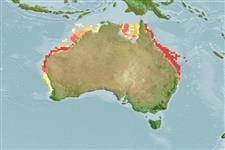>
Scombriformes (Mackerels) >
Scombridae (Mackerels, tunas, bonitos) > Scombrinae
Etymology: Grammatorcynus: Greek, gramma = signal, mark + Greek, rhyngchos = snout.
More on authors: Quoy & Gaimard.
Issue
Date Eschmeyer, pers. comm. Correction to Grammatorcynus is probably unjustified (Ref. 1830).
Environment: milieu / climate zone / depth range / distribution range
Ecologie
marien rifbewoner; oceanodroom (Ref. 51243); diepte 15 - 50 m (Ref. 86942). Subtropical; 12°S - 37°S, 110°E - 157°E (Ref. 168)
Western Pacific: known only from the northern coasts of Australia, south to Shark Bay in western Australia, along the east coast of Queensland south to northern New South Wales. Recently reported from the Gulf of Papua (Ref. 9684) and Ouvéa Atoll, Loyalty Islands (Ref. 13236).
Grootte / Gewicht / Leeftijd
Maturity: Lm ? range ? - ? cm
Max length : 112 cm FL mannelijk / geslacht onbekend; (Ref. 40637); max. gepubliceerd gewicht: 13.5 kg (Ref. 168)
Dorsale stekels (totaal) : 11 - 13; Dorsale zachte stralen (totaal) : 10 - 12; Anale stekels: 0; Anale zachte stralen: 11 - 13; Wervels: 31. Mouth relatively small, upper jaw reaching about to middle of eye. Pectoral fins stout. Interpelvic process short and single. No prominent anterior corselet present. Swim bladder present. Vertebrae 14 precaudal plus 17 caudal, total 31 as in the mackerels (Scomber and Rastrelliger).
Form schools near individual bays and reefs in Barrier Reef waters. With the rising tide, they move into shallow water over the reef flats, feeding on schools of clupeoid fishes that concentrate there. Utilized as a food fish.
Levenscyclus en paargedrag
Maturiteit | Voortplanting | Paaien | Eieren | Fecunditeit | Larven
Collette, B.B. and C.E. Nauen, 1983. FAO Species Catalogue. Vol. 2. Scombrids of the world. An annotated and illustrated catalogue of tunas, mackerels, bonitos and related species known to date. Rome: FAO. FAO Fish. Synop. 125(2):137 p. (Ref. 168)
Status op de Rode Lijst van het IUCN (Ref. 130435: Version 2024-2)
Gevaar voor de mens
Harmless
Gebruik door de mens
Visserij: commercieel; sportvis: ja
Tools
Speciale rapporten
Download XML
Internetbronnen
Estimates based on models
Preferred temperature (Ref.
123201): 22.6 - 27.8, mean 26.1 °C (based on 108 cells).
Fylogenetische diversiteitsindex (Ref.
82804): PD
50 = 0.7500 [Uniqueness, from 0.5 = low to 2.0 = high].
Bayesian length-weight: a=0.00955 (0.00460 - 0.01984), b=3.06 (2.89 - 3.23), in cm total length, based on LWR estimates for this (Sub)family-body shape (Ref.
93245).
Trofisch niveau (Ref.
69278): 4.5 ±0.80 se; based on food items.
Weerstandsvermogen (Ref.
120179): Gemiddeld, minimale populatieverdubbelingstijd 1,4-4,4 jaar (Preliminary K or Fecundity.).
Fishing Vulnerability (Ref.
59153): High to very high vulnerability (75 of 100).
Nutrients (Ref.
124155): Calcium = 13.5 [7.3, 31.5] mg/100g; Iron = 0.667 [0.348, 1.307] mg/100g; Protein = 22.5 [21.0, 23.8] %; Omega3 = 0.207 [0.118, 0.377] g/100g; Selenium = 18.2 [8.9, 38.7] μg/100g; VitaminA = 47.3 [15.5, 157.7] μg/100g; Zinc = 0.447 [0.293, 0.689] mg/100g (wet weight);
